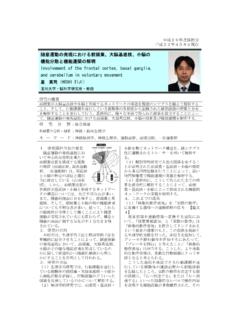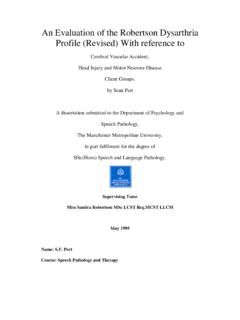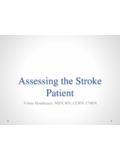Transcription of The Pandemonium of PANDAS by Melanie S. …
1 The Pandemonium of PANDAS by Melanie S. Weiss, BSN, RNC-MNN. Not to be confused with the black and white bears you may see at the zoo, this is an entirely different animal.' PANDAS , pronounced like the bears, is an acronym for Pediatric Autoimmune Neuropsychiatric Disorder Associated with Streptococcus. This disorder wreaks havoc on the unfortunate children who develop it and their unsuspecting families. PANDAS is a physical disorder with mental symptoms. Typically, it first appears as a virtually overnight dramatic transformation of the child resulting in sudden terror, significant regression in behavior, and the worst anxiety imaginable in a child you don't even recognize to be your own. The child does not know what has hit' him or her, and so is rightfully in a state of panic.
2 The symptoms are so sudden and dramatic, that the parents are left with paralyzing fear themselves. They will then rush from doctor to doctor to try to find out what has happened to their precious offspring, but will usually leave the doctor's office as bewildered as when they had first entered. Most physicians are not well educated about PANDAS . It is a relatively new disorder, only first recognized in 1998. Physicians may have heard of it, but because it is considered to be a rare disorder and in the absence of elevated strep titres, they will quickly dismiss it as a probable diagnosis. That's if they even obtain antistreptolysin-O (ASO) & anti DNA ase-B strep titres from your child. And, as more time passes the strep may become intracellular, therefore the blood tests (titres) will ultimately be negative.
3 In some cases, parents will be referred to a psychiatrist or neurologist for further evaluation, but many will more than likely be left to figure things out on their own. In other cases, parents may be blessed with a pediatrician who will dig further, obtain blood work, and help obtain a proper diagnosis. Unfortunately, this seems to be the exception and not the rule. PANDAS has been a controversial diagnosis among the medical community, but it is beginning to get the credibility it deserves, more recently. Widespread knowledge of its existence desperately needs to occur because so many children around the globe suffer needlessly for way too long. It is apparently not as rare as once thought.
4 There is help for PANDAS sufferers and potentially a cure. The Progression of PANDAS . The intense anxiety experienced by these children is quickly followed by the development of obsessive-compulsive disorder (OCD) and tics or Tourette's Syndrome (TS). Their whole world is turned upside down. They are suddenly behaving in ways they never did before and the child is well aware of it. They are so frightened by it, as are the parents. As if this isn't enough to bear, it is accompanied by age regression, bedwetting, deterioration of math and/or handwriting skills, separation anxiety, and a myriad of peculiarities that continue to evolve. The child will literally cling to the parent, typically the mother, following them from room to room and refrain from going to school.
5 The child also tends to experience stomach aches and headaches. Anorexia can become a serious issue as the child is fearful of eating food, either from fear of choking or from an irrational fear about the food and what might happen if they eat it. Obsessive thoughts are paramount, leading to compulsions and then tics. The typical profile of a child with PANDAS is that he or she is very intelligent, articulate, and considered a good student. It is believed that the child contracts streptococcus bacteria. The antibodies that would typically fight this infection turn on the host, prompting an autoimmune response. The antibodies, in turn, attack the basal ganglia of the brain causing inflammation.
6 This is essentially a form of encephalitis, whereby the blood-brain barrier is left extremely vulnerable. Hence, the OCD, tics, headaches, and unusual behaviors. The nature of PANDAS is that symptoms wax and wane. However, whenever the child is exposed to any new organism, there is an exacerbation in symptoms as the antibodies go to work again in their dysfunctional manner. New findings suggest that streptococcus may not be the only culprit. This would also explain why some children do not present with elevated Strep titres. Instead, a child may have elevated mycoplasma or Lyme (flagella-related) titres, for instance. Researchers with the NIMH have recently added the name, PANS (pediatric acute neuropsychiatric syndrome) to include severe onset caused by other illnesses such as: chicken pox, flu, mycoplasma and lyme Medical Interventions Antibiotics, especially Azithromycin and Augmentin, have shown promise in helping to curb symptoms to some degree.
7 These antibiotics will obviously help prevent any new bacterial infection, with the former working against mycoplasma and the latter working against strep, but even more significant is that Augmentin possesses a neuro-protective (anti-inflammatory). property over the basal ganglia. However, their use must be long-term over many years and dosage increased for a period of time with any new exposure or sometimes when dental work needs to be done. Since a known exposure is not always the case, the increased symptoms serve as a tell-tale sign. Selective Serotonin Reuptake Inhibitors (SSRI's) have been used to help reduce symptoms, although their use is not really encouraged. It is thought that by the time the child has been on the medication long enough to see any improvement, in many cases, the symptoms would have begun to wane on their own.
8 So, it is not known for sure if the SSRI's are truly helping and they have many potential adverse side effects. A steroid burst has shown to be effective in some children, due to its anti-inflammatory properties, but the long term use of steroids is not advised so this is not a viable option. Some children have had their tonsils and adenoids surgically removed, as strep and various other bacteria tend to hide in these areas. This surgical option seems to have been the key to the long-term health of many PANDAS . children. Intravenous immune globulin (IVIG), although considered experimental for use in PANDAS at this time, has shown to be effective. The dysfunctional antibodies are overtaken by the incoming normal' antibodies from donor immune globulin.
9 This causes the bone marrow to shut down, temporarily. When the body is then ready to make new antibodies, the bone marrow reboots itself and normal functioning antibodies are created. Thus, the vicious cycle of PANDAS comes to a halt and over a relatively short period of time the child is symptom-free, or essentially cured. This procedure typically takes place in an ambulatory setting over a two day period. The amount of immune globulin given is based on the child's weight and is infused over many hours. After day one, the child leaves the facility with a hep-lock in place. After day two's infusion, at times the child may develop a severe headache and vomiting. The headache can be managed with Tylenol, Ibuprofen, or in some cases a steroid.
10 In just a few months time, the child's symptoms may begin to disappear. Although, for some recovery may take longer, as the longer a child has had the disorder, the longer it may take to work. It may take up to one year to experience the full benefit of IVIG. And in some cases, a second round of IVIG may be necessary. IVIG has the ability to reverse any damage to the basal ganglia. There are current IVIG studies taking place through Yale University and the National Institute for Health (NIH). The Impact of PANDAS . Not all children who have OCD or TS will have PANDAS . But, it is worth the time and effort to rule out the possibility, should it turn out to be the case. It's especially worth pursuing if there was a sudden onset of symptoms following a strep infection or other illness.






